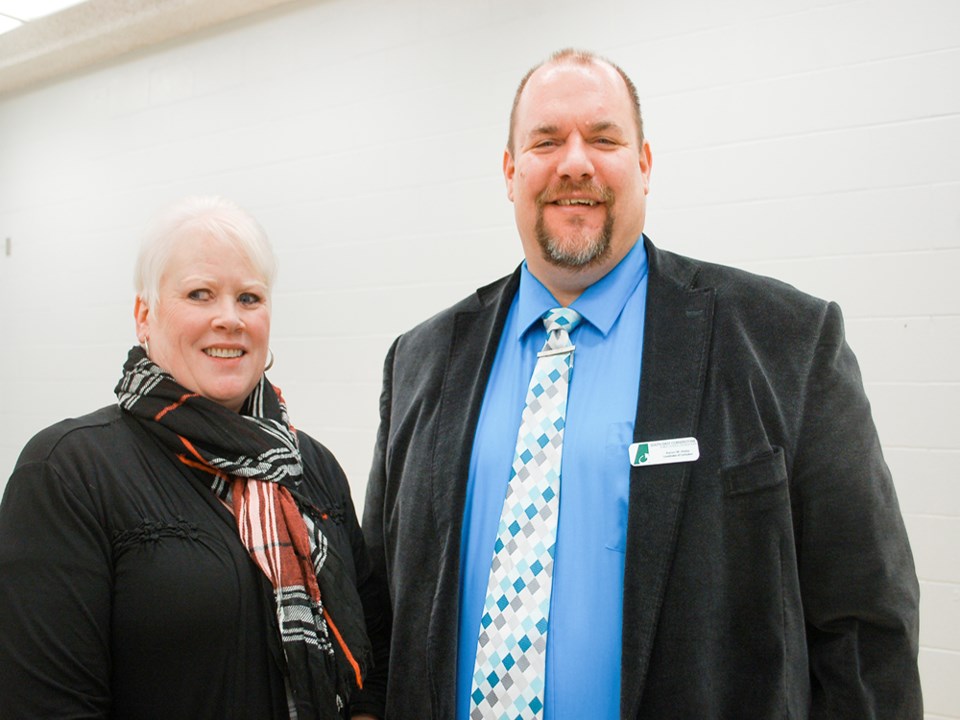When the surveys and seminars were made last spring, which resulted in the Cornerstone Tomorrow report, one common element kept cropping up as a topic that needed further attention. That one common question, put in various forms, focused on the current grading and assessment practices utilized by the South East Cornerstone Public School Division and their outcomes-based reporting.
The new grading system has been a part of the school system for four years now, but questions about how it works were persistent.
With that in mind, Sandi Klatt, co-ordinator of early learning for the division, and Aaron Hiske, the division’s curriculum co-ordinator, set out on a four-stop media tour within the division on Nov. 13 with the hope that the press would assist in spreading the word about the new assessment and grading regime.
The 20-minute presentation for Estevan was conducted at the Estevan Comprehensive School.
Using some graphic tools, Klatt and Hiske said the common concerns surrounding the new ‘marking’ system appeared to focus on how things were pieced together and then, what changes had to be made to make it understandable for all concerned, especially the students’ parents and guardians.
“This tour is a direct response to what the board members heard,” said Hiske.
Assessments have changed in the way they are recorded. Observations of student progress are more direct and curriculum achievements are more fully recognized, the two presenters stated.
Armed with better information, teachers, parents and guardians can arrive at defined conclusions and plans for the young person under their care.
“The monitoring of student progress can be made along the way,” said Klatt.
Marks such as an M instead of an A or A+ might lend itself to confusion, they said, but when parents learn that M means their youngster has “mastered” a course requirement, either right now, or was quickly getting there, then that helps them understand the monitoring and assessment process.
In the new world of grading, A means the student has “attained” a certain level while a B suggests they are “beginning” to get the concept of what is being taught in the class.
An E will indicate the student is “experiencing” difficulty and an I points out there is “insufficient evidence” to provide any other mark. In other words, the student has missed several classes and hasn’t provided enough evidence of comprehension or they simply are not understanding what is before them which will, more often than not, trigger the division’s support systems to help them get to that point of understanding and a capability to do the required work.
“It’s much more comprehensive and ongoing compared with the old percentage marking system,” said Hiske, using an illustration of what a parent would not know, when her child came home with a mark of 65 per cent or 72 per cent.
“They wouldn’t know what area of the work they weren’t getting, while with the new system, with individual outcomes, it’s pointed out what part they are getting and what part they may be struggling with in the class,” said Hiske.
The teachers, on the other hand, can now easily identify problem areas within an entire classroom and what pieces of instruction they are delivering that the whole class might not be understanding.
Hiske and Klatt said the senior high school students are still marked by numerical percentages, mostly due to the current requirements of many post-secondary institutions, but that is slowly changing as everyone gets aboard with the more defined system of monitoring a student’s progress.
“Parents can also go online and receive updated information on their child at any given time. No more hiding the old report card,” he said with a chuckle.
Both said students have specific learning targets within the current system, since it’s clearly shown what they should focus on versus what they’ve already mastered.
It’s still regarded as a new system, this MABEI scale, but, Hiske noted, the levels on the scale provide a clear picture of student achievement based on evidence collected by the teacher throughout the course of the school year. That gives the student a clear target (outcomes) for future reference.
It’s more descriptive, they argued, and once the scale is understood, it becomes clear as to which outcomes the student has achieved, ones he or she has started to understand and which ones he or she has struggled with.
Following the presentations in Weyburn and Estevan, Hiske and Klatt travelled to Carlyle and Moosomin to deliver similar presentations to media in those communities.




